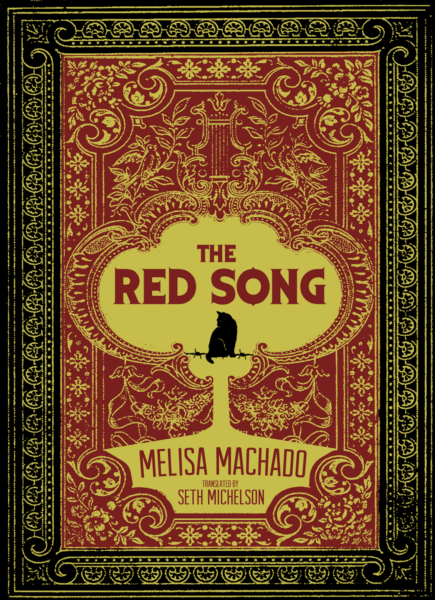
Johannes Göransson: Your poems in The Red Song reference the poetry of Paul Celan. What drew you to his work?
Melisa Machado: I’ve been reading Celan since I was 24. There’s no way to escape his influence. At a certain point I realized that what I was writing somehow dialogued with his images, with his sensitivity, with his way of seeing the world and people. I’m referring mostly to his first book Poppy and Memory. This isn’t something I did deliberately or consciously, but rather “automatically.” What I mean is I don’t write with the parts of my brain related to the neocortex or cerebral cortex but rather with those that correspond to the limbic and the reptilian, those that respond to both the emotional and the “little animal” we all carry inside.
In a word, I write intuitively. I let myself be guided by what falls or emerges from the waters of myself, my unconscious. I open myself to what is, I don’t look for the form until much later. You could say poetry moves through me. I’m only a vehicle through which it expresses itself and reaches an aesthetic, which I later express as verse. In a secondary process, I use the most developed part of the brain, my cerebral cortex, my most rational part, to make corrections and prune the text like someone pruning a tree that has grown too many branches. In this way I arrive at a concentrated meaning: the pre-existing center, or like an artisanal truffle, that seems to concentrate at its core the flavor of cocoa, and other flavors too, in all their splendor.
JG: You also do therapeutic work—can you describe what it is you do? Does this work influence your poetry?
MM: Undoubtedly, my therapeutic work affects my poetry and it affects my work, which is above all, working on myself, on the self, in the Jungian sense.
Ever since I had a very serious accident when I was 21, where I hit my face against the windshield of my car and suffered deep cuts on my cheeks (I got hit head-on, I was asleep in the passenger seat and the car didn’t have seat belts), plus the death of my partner a year later in another accident (it didn’t involve me but it occurred almost simultaneously), I entered into a deep degree of introspection, internal work, and resilience. I was very young; I was already writing and studying Literature and Psychology at the University, but I abandoned formal education for years to dedicate myself to writing poetry and exploring different techniques of self-knowledge and body therapies, both alternative and complementary, techniques that allowed me to understand what had happened. At a certain point, when I was around 37, after having lost both my parents (I’m an only child) I “naturally” became a therapist. And that’s my job today, besides writing. I am a Gestalt therapist, a Family Constellator, and a Zen Shiatsu and Traditional Chinese Medicine therapist. This is in addition to my interest and my studies in Taoism, Therapeutic Astrology, and the 5 Biological Laws, among other disciplines.
JG: I’ve seen recent footage and video on social media of your recent work, which seems increasingly ritualistic. Can you describe this work for us? What’s the role of ritual in this work?
MM: Rituals are part of a practice that can include meditation based on any spiritual current or Psychomagic, so well described by Alejandro Jodorowsky, another artist-therapist quite misunderstood by Western academic minds. I suppose that the photos or videos on my Instagram or Facebook wall, or on my blog, only reflect the most external part of my internal work and are fundamentally aesthetic but with ethical content. I meditate, I look at the sky and the earth, I honor the fire, the day, the night, and everything that happens in the three planes: the celestial, the terrestrial, and the human. I use different techniques so that my mind, my body, and my spirit are comfortable receptacles that I occasionally inhabit for the duration of my life on Earth. Meanwhile I write and work as a therapist making the use of language, mind, and body a single ritual.
JG: The Red Song was originally disseminated over social media. Can you describe that process? How did this affect the poems in that book? How has the recent work been influenced by social media?
MM: There’s a misunderstanding here that probably arose from the fact that we don’t express ourselves in the same language. This didn’t happen with The Red Song but with a previous book: Jamba de flores negros [Black Flower Doorpost], initially written from a series of interviews that I did, as a cultural journalist, with a Uruguayan visual artist named Javier Bassi. I first wrote the book on my cell phone, via text message, due to the simple fact that I would leave this artist’s workshop with my head full of images that emerged from our encounters and the work. I’d write the poems almost automatically, as I was headed back home. Then I’d send them directly to him without editing. My cell phone was the only thing I had on hand to write them at the time. Then, when I got home, I’d keep writing, and start the second process of correction.
It wasn’t even a smartphone but a basic cell phone, without social media. In the following years I realized that I was able to write poetry directly, on any medium, not just a notebook, a napkin or any piece of paper, but also on my cell phone, on my computer or directly on the wall of any social media. I’ve never thought about the target audience my poetry might be intended for. I just write. What’s been happening to me for about five years is that I take photos with my cell phone and write from those images and post them on social media, without thinking much about it. This is undoubtedly a “new” way of generating a visual poetic text that I create almost spontaneously and then “publish” in a kind of almost immediate present. Here I also use what I call the secondary process, editing and correcting, where I take up fragments or entire verses and then rewrite or write poems, which will later form part of a book that will eventually become a physical medium, on paper.
JG: What are you reading these days? What other projects are you working on?
MM: I read lots of poetry and books about different therapeutic disciplines at the same time and I often jump from one thing to the other. I mostly reread books by poets I love: Paul Celan, Antonio Gamoneda, Hilda Hilst, Clarice Lispector, Olga Orozco, Marosa di Giorgio, to name a few. And Rumi and Lao Tse: the Tao Te Ching, the Wen Tzu and the I Ching, those great reservoirs of wisdom and stylistic beauty.
Regarding contemporary therapeutic disciplines, I have not found aesthetic marvels other than The Red Book by Carl Gustav Jung, a vast and incomprehensible book for most minds, especially if you try to read it rationally. For me it’s an example of the naked unconscious and for that very reason, highly poetic.
I can also go from Jung to Susan Sontag or Anne Carson, or from Rumi to Bert Hellinger or Ken Wilber and from these to Su Nu Ching, the Yellow Emperor’s treatise on sex.
As for my latest projects, I’ve just finished writing, and publishing in digital format, two books of poetry: India and Mother. They are not translated into English and they can be purchased through Amazon, in Spanish.
I write every day. I never know exactly what I’m writing about. I don’t follow a plan. This is what my process is like: I write, sometimes in a notebook, sometimes on my computer or directly on social media. At a certain moment I realize I have a book, pre-drawn or predefined by my unconscious, so I take it, give it an order, rewrite it, put it together. Then I bring it out into the world: I make room for it.
translated by Katherine M. Hedeen

Melisa Machado was born in Durazno, Uruguay, in 1966. She lives in Montevideo. She is a poet, journalist, writer, art analyst and therapist. Her books Ritual de las Primicias (1994), El lodo de la Estirpe (2005), Adarga (2000), Jamba de Flores Negras (2006) and Marjal o Animal (2008) were collected in Rituales (2011). El Canto Rojo was first published by the Sediento Ediciones (Mexico) in 2013. Her poems have been included in several anthologies, including El Amplio Jardín (2005), Nada es igual después de la poesía: Cincuenta poetas uruguayos del medio siglo, 1955-2005 (2005) and The World Record (2012). Her work has previously been translated into English, Italian and Swedish.
